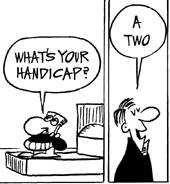 What’s your handicap? If the king asks, don’t answer!
What’s your handicap? If the king asks, don’t answer!
History
In the early 20th century, the United States Golf Association (USGA) introduced a handicap system aimed at allowing players of all skill levels to compete against one another. In other words, and theoretically, the handicap system allows a player who has trouble breaking 90 to compete against Tiger Woods. This is done by granting the weaker player “strokes.” On tough holes, the less skilled player is allowed to take a stroke (or more) off of his score.
The USGA handicapping system was fitted in the 1980s with a new gadget: the “slope rating.” The slope rating aimed to level the playing field (pun intended) by accounting for the relative difficulty of different courses. Thus, handicapping involves three numbers: your score, the course rating, and the slope rating.
Definitions
The course rating is the average score the upper half of scratch golfers are expected to achieve. If your course rates a 73.1, and you put 100 scratch golfers and said “play,” the top 50 should average 73.1. Slope rating represents the difficulty for bogey golfers, and can range from 55 to 155. 113 is about average. Bogey golfers face different challenges than scratch golfers, so these numbers may not always be proportional from course to course.
To compute a player’s official USGA Handicap Index, a complex formula is used. The formula takes into account a player’s recent scores, course ratings, and slope ratings. Players must have completed at least five rounds to compute a handicap index, and when more than 20 are provided, the best 10 of the last 20 are used.
Once a golfer has his handicap index, he can use that to determine his course handicap. These are not the same number – a golfer is given more strokes on a harder course than on an easier course. To compute your course handicap, you need only know your handicap index and the slope rating.
Computing Your Handicap Index
The easiest way to compute a handicap index is to join a club or Web site that will do it for you. Then, it’s simply a matter of entering your scores when you get a chance. If you wish to compute your own handicap index, here’s how:
Step One
Gather the scores, course ratings, and slope ratings for your most recent five to twenty scores. Use as many as you have available. Using those numbers, run each round through this formula:
(Score - Course_Rating) * (113 / Slope_Rating)
If you shoot 83 on a course with course and slope ratings of 71.5 and 123.4, your differential for that round is (83 – 71.5) * (113 / 123.4) = 10.5. Calculate this differential for each round.
Step Two
You don’t use every differential to calculate your handicap index. If five scores are available, the lowest differential is used. If 20 rounds are entered, the 10 lowest differentials are used. Here’s a chart showing the proper number of differentials:
# Rounds Used --------------- 5-6 1 7-8 2 9-10 3 11-12 4 13-14 5 15-16 6 17 7 18 8 19 9 20 10
Step Three
Average the differentials used and multiple the result by 0.96. Drop the digits (without rounding) beyond the tenths spot and – bada bing, bada boom – the result is your handicap index.
Applying the Results
Say you’ve computed your handicap index to be 10.9. You’re playing your buddy, who has a handicap index of 21.6. You consult the course at which you’ll be playing to find that their slope rating provides you with 11 handicap strokes and your friend with 23: you owe your friend 12 strokes. The score card most likely has a row marked “Hdcp” with numbers ranging from 1 to 18. Your friend is given one stroke apiece on holes with the handicap of 1 through 12.
The #1 handicap hole is supposed to be the toughest on the course, and the #18 handicap hole the easiest. Because par fives offer more chances to “screw up” and because par threes offer less, par threes often occupy slots 15 through 18 while par fives often take up 1 through 4.
Check with the tournament committee to see how you should apply your handicap index before competing in tournaments, leagues, or other forms of play.
Keeping Score
In the late 1990s, the USGA modified the handicapping system to disallow scores greater than six by anyone possessing a handicap index of 9.0 or less. This system was modified to allow for double bogeys on par fives by skilled players, but keeps the remaining brackets intact. You can see a table here or just below:
Handicap Max. # on any Hole <= 9 Double Bogey 10 - 19 7 20 - 29 8 30 - 39 9 40+ 10
Other Resources
There are a lot of other resources available. A few great ones on the USGA.org site follow:
- Articles & Resources
- Course Ratings Database
- Course Handicapper
- Handicap Revision Schedule
- Handicapping Quiz
- Handicap Index Rankings
- Online Handicap Seminar
The End
Now get out there and play.

I use GHIN which is recognized by the USGA… http://www.golfserv.com/gdc/homepages/handicaptracker.asp